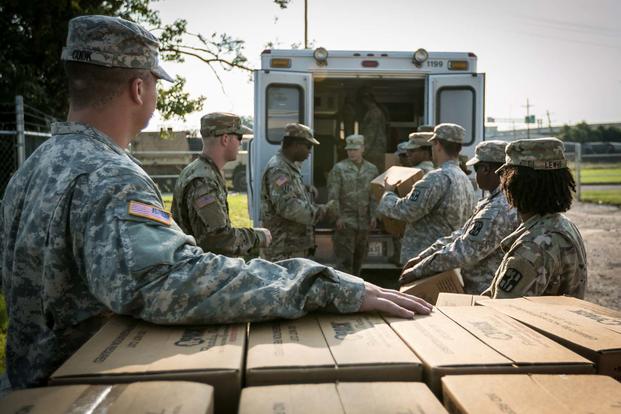As floodwaters slowly receded and skies finally cleared, military and civilian relief efforts went into high gear Friday in Texas, with the Army alone deploying 16,000 soldiers into the response.
At a news conference with military commanders in Austin, Texas Gov. Greg Abbott said he's received offers of help from all 50 states and accepted assistance from 43. He didn't rule out taking up offers from the other seven.
President Donald Trump is scheduled to visit the state Saturday for the second time since Hurricane Harvey hit the Gulf Coast last Friday as a Category 4 storm.
Vice President Mike Pence and several Cabinet secretaries were in Texas on Thursday.
Related content:
- VA Dispatches Mobile Clinics to Texas for Harvey Relief Efforts
- US Military Begins Surveillance Flights Above Houston
- Two Navy Warships Underway for Storm Relief in Texas, Louisiana
- Here's How Harvey Is Impacting Military, Veteran Benefits
- What Hurricane Response Activation Means for National Guard Families
In addition to assets already in place, two Navy ships -- the amphibious assault ship Kearsarge and the dock landing ship Oak Hill -- were en route to the Gulf Coast with Marines and their amphibious vehicles and MV-22 Osprey tilt-rotor aircraft aboard from the 26th Marine Expeditionary Unit, based at Camp Lejeune, North Carolina.
"They're about four days out," Air Force Gen. Lori Robinson, commander of U.S. Northern Command and the North American Aerospace Defense Command, said of the Kearsarge and the Oak Hill.
But given the magnitude of the military response thus far, the assistance of the two ships will be called upon only if needed, Robinson said.
The Army said in a Facebook post that more than 16,000 soldiers from 23 states are involved in the response in Texas and Louisiana to Hurricane Harvey and its spinoff storms, which have dumped record rainfalls and caused widespread flooding.
The soldiers involved are from aviation, transportation, engineering, communications and rescue units, the Army said.
Through early Friday, they had rescued more than 6,000 people and about 300 pets, the service added.
In the process, the Army has committed about 700 wheeled vehicles and 90 helicopters to rescues and to bringing food, water and tents to victims.
"One of the things that we've learned over time is how important it is to have the right capability at the right place at the right time," Robinson said.
She said Defense Secretary Jim Mattis had given her a simple order: "Lori, Texas gets everything they need."
Robinson said the military is ready to deploy more capabilities at the request of either the Federal Emergency Management Agency (FEMA) or the Texas governor, and will continue to deploy as much as is requested or needed.
The Air Force is providing airlift of survivors by aircraft such as the C-130 Hercules and C-17 Globemaster III, as well as medical evacuation by rotary aircraft. The service has also provided aircraft for command and control and helicopters to transport people and supplies, Robinson said.
An Air Force E-3 Sentry airborne warning and control system, or AWACS, aircraft is conducting air traffic control and surveillance, gathering data on flooded areas and provide situational awareness.
The Navy has helicopters flying rescue missions and a P-8 Poseidon surveillance plane that is usually deployed for reconnaissance and finding submarines.
The Defense Logistics Agency has "provided fuel, sandbags, generators and incident support bases and is delivering meals to dislocated citizens," Robinson said.
The U.S. Army Corps of Engineers has experts in Texas to support FEMA and local communities in technical assistance, such as power restoration, she said.
"We will be there, steady, ready and to support at a moment's notice," Robinson added.
-- Richard Sisk can reached at Richard.Sisk@Military.com.
-- Oriana Pawlyk can be reached at oriana.pawlyk@military.com. Follow her on Twitter at @Oriana0214.
Related Video:






























